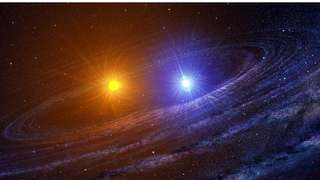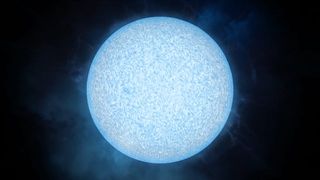
A red giant star and a smaller and younger companion approach each other in a prelude to a collision that will birth a blue supergiant star.
(Image credit: Casey Reed/NASA)
Astronomers may have solved the mystery of how some of the brightest and hottest stars in the cosmos are born.
The team, led by researchers at the Instituto de Astrofísica de Canarias (IAC), found clues that suggest blue supergiants are created when two stars in a binary system spiral together and merge.
B-type blue supergiant stars are at least 10,000 times brighter, two to five times hotter and 16 to 40 times more massive than the sun. Blue supergiants are so extreme that scientists have theorized that they may have been created during a rare and brief phase of stellar evolution.
The problem with this idea is that it should mean blue supergiants are a rare sight, yet they are commonly observed throughout the universe. As a result, their origins have puzzled scientists for decades.
Related: 1 in 12 stars might have swallowed a planet
There is a clue as to the nature of blue supergiants: They exist alone, with no gravitationally bound companion star. This is odd, because the more massive a star is, the more likely it is to have a companion. Around 50% of stars the size of the sun have a companion, but around 75% of much more massive stars are accompanied.
Yet blue supergiants, some of the most massive stars, are lonely. The reason for this may be that blue supergiant stars exist in systems in which the occupants have already spiraled together, collided and merged.
Breaking space news, the latest updates on rocket launches, skywatching events and more!

An illustration of the B-type blue supergiant star LS1. (Image credit: ESA/Hubble, M. Kornmesser)
The team of scientists set about investigating this by analyzing 59 early B-type blue supergiants located in the Large Magellanic Cloud, a satellite galaxy of the Milky Way, and creating novel stellar simulations.
“We simulated the mergers of evolved giant stars with their smaller stellar companions over a wide range of parameters, taking into account the interaction and mixing of the two stars during the merger,” study leader and IAC researcher Athira Menon said in a statement. “The newly born stars live as blue supergiants throughout the second-longest phase of a star’s life, when it burns helium in its core.”
The team’s findings suggest that blue supergiants slip into an evolutionary gap in conventional stellar physics — a phase of stellar evolution where astronomers would not expect to see stars. The question is, Can this explain the remarkable properties of blue supergiant stars? It seems the answer is yes.
“Remarkably, we found that stars born from such mergers have greater success in reproducing the surface composition, particularly the nitrogen and helium enhancement, of a large fraction of the sample than conventional stellar models,” team member and IAC researcher Danny Lennon said. “This indicates that mergers may be the dominant channel to produce blue supergiants.”
The new results could represent a large step toward solving a lingering problem regarding the birth of blue supergiant stars, also indicating the importance of binary star mergers in shaping the stellar populations and overall shapes of galaxies.
The next step in this research will see the team switch attention from the birth of blue supergiant stars to the death of these massive objects. The scientists will investigate how the supernova explosions of blue supergiant stars create neutron stars and black holes.
The team’s research was published earlier this month in the Astrophysical Journal Letters.
Join our Space Forums to keep talking space on the latest missions, night sky and more! And if you have a news tip, correction or comment, let us know at: [email protected].
Robert Lea is a science journalist in the U.K. whose articles have been published in Physics World, New Scientist, Astronomy Magazine, All About Space, Newsweek and ZME Science. He also writes about science communication for Elsevier and the European Journal of Physics. Rob holds a bachelor of science degree in physics and astronomy from the U.K.’s Open University. Follow him on Twitter @sciencef1rst.
>>> Read full article>>>
Copyright for syndicated content belongs to the linked Source : Space.com – https://www.space.com/blue-supergiant-stars-origin-mystery-solved






























